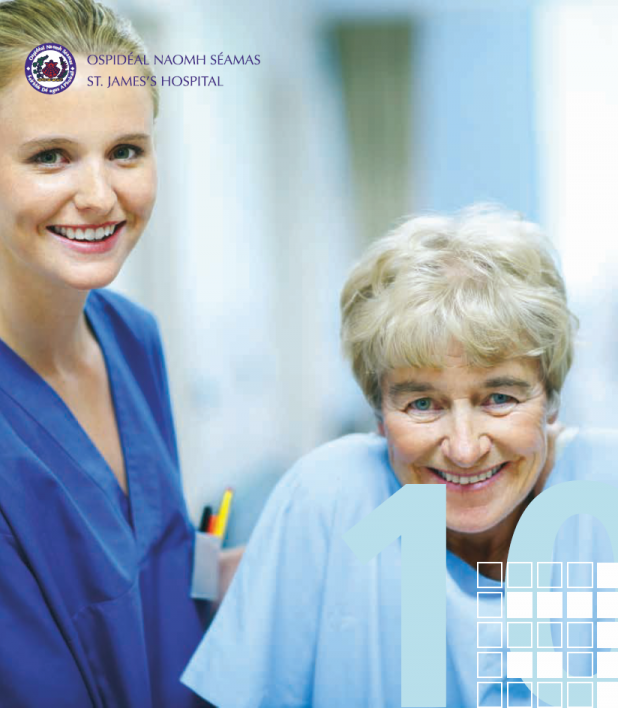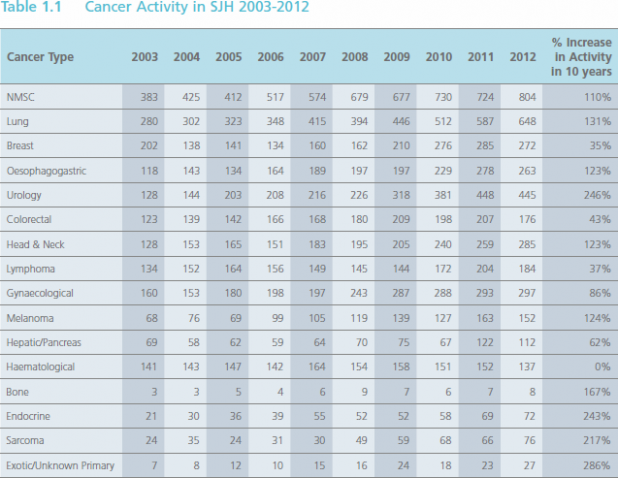
St. James’s Hospital, here in Dublin 8, has been making the news today after it released a major report, the first of it’s kind to be undertaken in Ireland. The 10 Year Cancer Audit basically compiles data from a period of a decade, relating to patients who have been treated for various cancers at the hospital.
This report was compiled by the Cancer Audit Programme (CAP) at St. James’s Hospital, which was established in 2001. Their goal is… to provide comprehensive prospective data on the structures, processes and outcomes of cancer care provided by the many national, supra-regional and regional cancer programmes in the Hospital. Their first report was in 2004, followed by a six year report of incidence and outcome cancer data in 2008, the first report of its kind in Ireland. This latest report is the first ever 10 year Irish cancer audit.
The major deal with this report, is that it tracks the (rising) numbers of people that have been diagnosed with cancer over the last decade, their treatments, and their outcomes, which obviously tell us how effective those treatments are.
This data will now be used by the Health Service Executive (HSE), the Department of Health, the National Cancer Control Programme (NCCP), and the Health Information and Quality Authority (HIQA) as a source of information that will help them to develop their clinical strategy’s. This can only add to our local general hospital’s profile, not only in Ireland, but abroad aswell, because this data will be viewed, and possibly used in some way, by many other western national health services too.
Download PDF: 10 Year Cancer Audit Report, by Cancer Audit Programme Team, St. James’s Hospital
So, what’s exactly in the report?
This is a pretty large report – numbering over 100 pages in total, so in essence, there is a whole lot in it. The information is quite specialised, therefore it wouldn’t be appropriate for me to comment too much. However, there are some of the key findings in the report’s executive summary, and that’s probably a good place to start looking.
EXECUTIVE SUMMARY:
- A marked increase in cancer care took place over this 10 year time period. In 2012, almost 4000 new cancer patients were diagnosed and/or treated in St. James’s Hospital. Excluding non-melanoma skin cancer this represents an approximate doubling of new cancer referrals over the study period.
- There has been an approximate 100% increase in new referrals for lung cancer, oesophageal cancer, stomach cancer, head and neck cancer, and malignant melanoma.
- Breast cancer activity has increased by 35%, colorectal cancer by 45%, and gynaecological cancer by 85%.
- The average age of patients diagnosed and/or treated in SJH is 60 years. There were 14677 women diagnosed compared with 14,144 men.
- Cancer outcomes across the spectrum of cancer at St. James’s Hospital compares favourably with international benchmarks.
- The average cancer clinical trial involvement over the period is approximately 6%, with a peak of 16% in 2008.
- Imaging for cancer, including MRI, CT, PET/CT and mammography, has doubled, from 30,000 in 2006 to 60,000 in 2012.
- There exists cognate complex cancer surgery for lung, oesophageal and head and neck cancer, which overlap with respect to complexity of surgery, multidisciplinary care, integrated perioperative care pathways, critical care support, quality of life issues, and cost. These respective services account for between 33-53% of the national workload. There are also strong cognate links between colorectal, urological and gynaecological cancers.
- Lung cancer is the highest volume cancer, with almost 700 new diagnoses in 2012, accounting for approximately 27% of the national workload. Less than 10% of cases are non-smokers, and the incidence is similar in current and ex-smokers. Encouragingly, 47% of patients have clinical stage I or stage II at the time of diagnosis, and can be treated with curative intent.
- St. James’s Hospital was recently designated as the National Centre for Oesophageal and Gastric Cancer and the National Centre for Management of Early Upper Gastrointestinal Mucosal Neoplasia. The hospital manages approximately 65% of oesophageal surgical resections nationally. Cure rates are improving, with overall survival at 35%, 65% for nodenegative disease, and 75% for Stage I/II disease, outcomes consistent with best international benchmarks.
- Gynaecological cancer care at St. James’s Hospital is designated by the NCCP as a regional and national referral centre for the care of women with genital tract malignancies. The service accounts for a significant percentage of national activity accounting for 37%, 28%, 26%, and 20% of vulval, ovarian, cervical, and endometrial cancer workload, respectively, with a 5-year survival of 68%, 48%, 67%, and 68%, respectively.
Download PDF: 10 Year Cancer Audit Report, by Cancer Audit Programme Team, St. James’s Hospital
From the report, here is an interesting breakdown of the major cancer groups, with their increases in rates diagnosed/treated at St. James’s Hospital over the past 10 years. This represents 12% of national cancer activity.


The Cancer Audit Programme Team (left to right): Lorraine Quinn, Sinead King, Suzanne Rowley, Prof. John Reynolds, Charlotte Stuart, Mary Devlin, Richard Lawson, Kerena Sutcliffe.
Download PDF: 10 Year Cancer Audit Report, by Cancer Audit Programme Team, St. James’s Hospital








